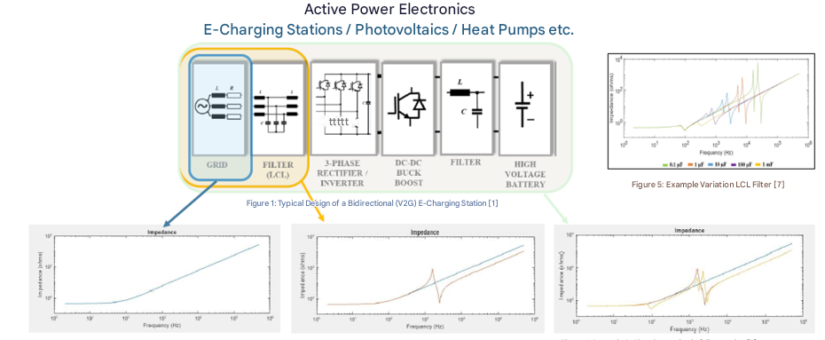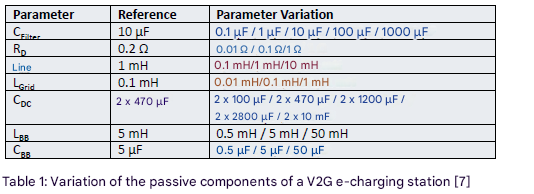
The effects of active power electronics on the higher frequency grid impedance up to 150 kHz
- Posted by Neo Messtechnik
- On 10. July 2025
- 0 Comments
- Active Power Electronics – High Frequency Grid Impedance, Analysis, Measurement

Bernhard Grasel, Jose Baptista, Manfred Tragner
University of Applied Sciences Technikum Vienna, University of Vila Real Portugal, NEO Messtechnik GmbH
Motivation
DC charging stations for electric vehicles use active power electronics to convert alternating current to direct current, which causes supraharmonic emissions (SH) in the frequency range of 2–150 kHz [1], [2]. To achieve high efficiencies, high switching frequencies of up to 100 kHz are used (using MOSFETs, IGBTs, etc.). To characterize supraharmonic emissions, it is important to distinguish between primary and secondary emissions. Primary emissions are generated by the electrical equipment itself (e.g., switching frequency and multiples thereof). Secondary emissions are generated elsewhere in the power grid and propagate due to the low impedance [3].
The propagation of supraharmonic emissions is a research focus of many universities (including TU Dresden, FH Technikum Wien, UTAD Vila Real, etc.) and has been highlighted in many publications [1], [2], [3], [4], [5]. A key component of this is knowledge of the frequency-dependent grid impedance up to 150 kHz. Few results from field tests are available, partly due to the lack of suitable measuring instruments. [6] shows that grid impedance in the harmonic frequency range (< 2 kHz) depends primarily on the components of the electrical grid. Grid impedance in the frequency range from 10 to 150 kHz is mainly influenced by high-power electronic devices (VFD motors, PV systems, EV charging stations), and grid impedance in the frequency range above 500 kHz is influenced by low-power electronic devices (power supplies, lighting, etc.).
Goals
This study analyzes the impact of a bidirectional electric vehicle charging station on the frequency-dependent grid impedance (10-150 kHz) using Matlab Simulink and a comparative measurement on a reconstructed electrical distribution network in the Smart Grid Lab at the University of Applied Sciences Technikum Wien (considering different grid topologies). Furthermore, the parameters of the passive elements are varied in the software simulation (see table), and a sensitivity analysis is performed.



Results and conclusions
- Even connecting the V2G charger (not in operation) causes resonances (parallel and series resonances) due to the connection of the LCL input filter.
- V2G EV charging stations can therefore be a sink for supraharmonic emissions, even when not in operation.
- Impacts
- Reduced service life of equipment due to additional heating
- Interference with other equipment (e.g., medical, navigation)
- Interference with Power Line Communication (PLC)
- The LCL filter capacitor affects the filter resonance (10-50 kHz), while the DC link capacitor affects the low-frequency resonance point (<2 kHz).
- The inductors used in LCL filters affect both resonance points, while the inductors after the AC/DC conversion have only a minor influence.
- Damping resistors can significantly reduce the gain/attenuation at the resonance points.



